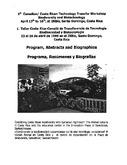| dc.description.abstract | The mahogany shootborer, Hypsipyla grandella (Zeller) (Lepidoptera: Pyralidae) is probably the main forest pest in the Neotropics, as it damages precious woods, such as mahoganies (Swietenia spp.) and cedars (Cedrela spp.). The action threshold for this pest is as low as one larva per tree, and its main damage consists of boring the tree terminal shoots, which causes forking of the steMON. Even though considerable research aimed at managing this pest has been conducted, management practices have not been feasible, which has frustrated attempts to establish commercial plantations of these species. Preliminary research has been carried out at CATIE (Turrialba, Costa rica), in order to pursue a preventative approach based upon the application of plant extracts which interfere with H. grandella behavioral and physiological aspects. A general screening test with 29 substances was carried out. They were extracted from different structures (leaves, wood, floral buds, bulbs, fruits, and seeds) of plants belonging to the following families: Alliaceae, Chenopodiaceae, Compositae, Cucurbitaceae, Labiatae, Lamiaceae, Leguminosae, Meliaceae, Myrtaceae, Poaceae, Rutaceae, Simaroubaceae, Solanaceae, Umbelliferae, and Winteraceae. The extracts were prepared at CIPRONA (Universidad de costa Rica). Third instar larvae arranged in a completely randomized design, were exposed to Spanish cedar leaf discs impregnated with a single concentration of each substance (10 percent). From this screening, six substances with possible antifeeding or inhibitory effects on larval growth were selected: wood and leaf extracts of bitterwood (Quassia amara), Simaroubaceae, a leaf extract of common rue (Ruta graveolens, Rutaceae), a fruit extract of "tacaco cimarrón" (Sechium pittieri, Cucurbitaceae), and two commercial products (Azatin and Nim 80) derived from neem (Azadirachta indica, Meliaceae) seeds. Laboratory bioassays confirmed that both bitterwood extracts and the common rue extract showed an antifeeding activity. These substances were tested in a greenhouse experiment. Spanish cedar terminal shoots were treated with the same concentration (10 percent), and three first instar H. grandella larvae were exposed. Treated plants were distributed in a completely randomized design, with a split plot arrangement through time (10 plants per treatment). From the three extracts, only Q. amara wood showed antifeeding activity. | es_ES |


